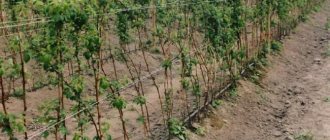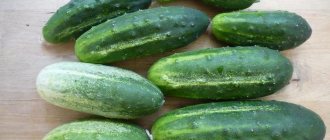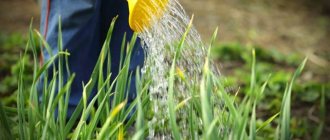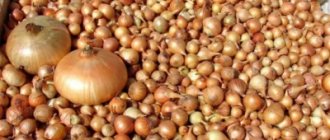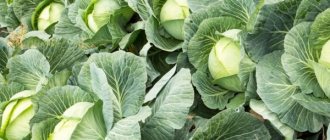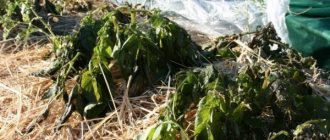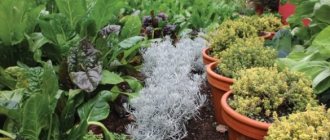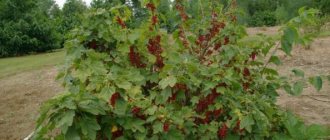Features of temperature conditions
Cucumber is a very heat-loving plant, if not heat-demanding.
Varieties of cucumbers.
Its growth processes can take place in the temperature range from 14.5 to 42 ͦ C. The optimal daytime temperature, conducive to normal growth and development of the plant, is from 25 to 30 ͦ C, the optimal night temperature is from 15 to 18 ͦ C.
Temperature requirements appear already from the moment of germination of cucumber seeds. The temperature at which they begin to germinate ranges from 10 to 12 ͦ C, and leaves and fruits begin to grow at 15-16 degrees. If you raise the temperature during seed germination to 25 ͦ C, then the process speeds up significantly and seedlings can be seen already on the fifth or sixth day after sowing, and if you raise the temperature to 17-20 degrees, seedlings will appear on the tenth day. If the temperature drops beyond +10 ͦ C, then the seedlings stop growing, instead they begin to turn yellow and rot.
Prolonged exposure to such a temperature entails irreversible pathological cellular changes in tissues, and if the minimum air temperature reaches +3-4 degrees, then within three to four days the plants usually die. If seeds are sown in frozen soil, you will not see seedlings until it warms up properly.
Structure of a cucumber
Roots. It has a very powerful root system, which consists of a main root, which in turn branches, producing very thin elongated white secondary roots. The roots of cucumbers reach a length of 90–120 centimeters. Sometimes a cucumber is able to produce above-ground roots.
Stem. Cucumber stems are angular and spiny, with tendrils that can grow up to 3.5 meters in length. A leaf and tendril begin at each node. The axils of each leaf produce a lateral bud and one or more flowers.
Leaves. The leaf is simple, located on a long petiole, with three more or less pronounced petals, dark green in color. The leaves are covered with very fine hairs and they are alternate and opposite to the tendrils.
Flowers. Flowers with a short peduncle and yellow petals. Flowers appear in the axils of the leaves and can be hermaphroditic or unisexual. The earliest varieties of cucumbers were monoecious and had male and female flowers. At the beginning of the flowering plant stem, only male flowers bloom. In the middle part of the plant, male and female flowers are in equal proportion, and finally, in the upper part of the plant, female flowers predominate. The percentage of male and female flowers varies depending on weather conditions. In order for more female flowers to form, short days, low temperatures and sufficient water are needed. The formation of male flowers requires long days, high temperatures and lack of water. All commercial varieties that are currently grown have only female flowers.
Fetus. The fruit is rough or smooth, depending on the variety. The color of cucumber fruit varies from light green to dark green. The pulp is watery, whitish in color, the seeds inside are distributed throughout the fruit. These seeds are presented in different quantities and are oval in shape, somewhat flattened and yellowish-white in color.
Harrowing and irrigation of crops
An example of growing corn and cucumbers together. The thermal regime of cucumbers is improved due to tall-stemmed corn.
During the seed growth phase in not too warm weather conditions, harrowing the crops is of great importance. An improvement in the thermal regime of a cucumber plantation is observed when growing high-stemmed canopy crops. Between the scenes, the optimal air temperature level in the presence of wind can rise by 1.5-4 degrees compared to unprotected areas. At the same time, in the southern regions these same curtains protect cucumber crops from overheating. The optimal temperature of the squat air layer can also be effectively regulated by irrigation. The temperature of the soil surface on irrigated lands tends to decrease, especially during the greatest heating, by 8-16 degrees; at a depth of 10 centimeters - by 3-7 degrees; at a depth of 20 centimeters - by 2-2.5 degrees; at a depth of 30 - by 1-2 degrees; at a depth of 40 centimeters - by 0.5 degrees.
In case of cold weather, plants bury themselves above the first internodes. Cucumber plants are extremely sensitive to frost. Plants die even with the shortest frosts of -1-2 ͦ C. Sudden changes in air temperature are especially unfavorable for cucumbers.
Favorable growing temperatures
Favorable for growing plants are the average daily air temperature, slight daily temperature fluctuations, and a slow decrease in temperature at the end of the growing season.
Night temperatures for growing cucumber plants that fall below +15-+13 degrees lead to a decrease in cucumber temperature and a decrease in yield. This pattern is explained by the fact that cucumber fruits grow mainly at night. If the temperature and air humidity drop simultaneously, cucumber plants are affected by a fungal disease called powdery mildew.
Cucumbers grow most intensively in the temperature range from 20 to 30 ºС. Different varieties have their own optimal temperature for best growth. Growing cucumbers will work better if the soil temperature is slightly higher than the air temperature.
What should the soil be like before sowing cucumbers?
It is recommended to start growing cucumbers after early peas, tomatoes, potatoes and corn. Cucumber is shade-tolerant, so it can be grown under trees, especially when using a trellis. The plant is demanding on the level of soil fertility, so it is worth starting in the fall to apply 80-100 kg of manure per 10 m2 or, as an alternative, 400 g of superphosphate, 250 g of potassium salt, and in the spring - 150-200 g of ammonium nitrate.
Scheme for fertilizing beds for growing cucumbers.
But if you want to get a rich harvest as a result of your labors, then applying mineral fertilizers alone will not be enough; in the spring you will need to add humus in a small amount, at least in the furrows or holes when sowing and planting. Ash in the amount of 150-200 g is also useful in spring.
In the fall you need to dig deep, and in the spring you need to harrow it, digging up heavy, swollen areas of soil. The best is a dotted sowing pattern with rows placed every 70 cm, and seeds in the row placed every 7-10 cm.
Predecessors of cucumbers
To grow cucumbers, you need to pay attention to crop rotation.
If you grow not only cucumbers, but also any other plant in the same place, you will get a decrease in yield.
Indeed, with this cultivation regime, the soil not only becomes tired, but also phytopathogens accumulate in it.
Therefore, it is recommended to grow cucumbers in the same place every 3-5 years.
The best predecessors of cucumbers: white cabbage, cauliflower, greens, legumes (except beans), potatoes, root vegetables (except carrots).
When and how to sow seeds in the ground?
You can start sowing seeds in open ground when the ground warms up to +12-+15 degrees. It is necessary to sow in three to four terms with an interval of 5-7 days. This planting tactic is carried out in order to obtain early growth results. If the early plants do not survive, at least those sown later will remain.
When the threat of frost has passed, excess plants should be removed.
Stages of growing cucumbers.
As a rule, cucumber seeds are embedded in the ground 3-4 cm deep. But you can practice different depths of embedding them in one hole. For this purpose, make an inclined hole with a hoe or place the seeds along a slope, starting from a depth of 6-8 cm and rising to 2-3 cm. This technique will make it possible to obtain seedlings depending on the temperature and soil moisture. If the top layer is highly moistened, shallowly located seeds will sprout, and if this layer dries out, seeds that were buried deep will sprout.
When the shoots appear, carry out loosening, and when the first real leaves appear, break through, leaving plants in rows every 12-15 cm and 3-4 per hole. At the same time, carry out the first feeding with fermented bird's milk, having previously diluted it with 5-6 parts of water or mullein solution. As an alternative, you can use diluted ammonium nitrate or urea in the amount of 15 g per bucket of water and the same amount of potassium sulfate. To remove fertilizer from plants, rinse them immediately with clean water. After 12-13 weeks, feed a second time, and before closing the lashes - a third time.
Conditions in a polycarbonate greenhouse for cucumbers
The temperature in the greenhouse for cucumbers and tomatoes is largely similar. Like cucumbers, tomatoes are a heat-loving crop and require a mild climate close to the Mediterranean.
The most important condition is warm soil before planting seedlings in a greenhouse. Not lower than 15! Moreover, you should ask about the weather forecast in advance. It is better to keep the tomatoes in the room for a couple of days longer than to doom them to die out in cold conditions.
It is important that the soil is warmed up
After 8-10 days, the tomatoes will feel much better if the temperature rises to 20-25 degrees. The greens will get stronger and look healthier. But there is also danger in rising temperatures. At this initial stage, it must be reduced again in order to prevent the bush from being strongly stretched, since all the force will go to the leaves, and it is important to strengthen and develop the roots.
Like cucumbers, tomatoes will not withstand cold temperatures down to 5 degrees; a mark near zero will cause the death of the plant right there.
Important! The night temperature for tomatoes is about 18 degrees, the daytime temperature is more than 20.
Experienced gardeners know that a lot depends on the selected tomato variety. There are hybrids that are not going to die in a short-term cold snap, even down to −3 degrees!
Regulating day and night temperatures in a greenhouse with tomatoes is no different from caring for cucumbers in a greenhouse. But these two cultures should not live in the same place.
Almost everywhere, in order to get a consistently high yield of this crop, it is necessary to plant it in protected soil, and polycarbonate is a reliable shelter for heat-loving cucumbers.
Advantages of the material:
- transparency (up to 85%), enough light penetrates inside for growth;
- strength and durability of the material (neither a layer of snow nor hail is scary);
- the ability to retain heat inside for a long time.
A comfortable climate for a cucumber is one of the fundamental conditions for successful cultivation. Temperature, air and soil humidity are its components. The microclimate should not be constant, it should undergo changes depending on the growth phase. In addition, it changes throughout the day (morning - day - night).
How to create the right microclimate with your own hands:
- bioheating is a reliable temperature regulator in a greenhouse; you don’t have to worry about the temperature state of the soil. Biofuel will not allow us to drop to dangerous numbers;
- Air humidity is maintained by proper watering, spraying water, and open containers filled with water;
- ventilation (airing) - saves from many troubles (heat, the development of diseases, excessive humidity, attracting insects for pollination. However, you should not overdo it with ventilation either, since all plants need carbon dioxide to develop, so keeping the door constantly open is also harmful.
Attention! High humidity in a greenhouse poses a threat at night due to the drop in temperature. When the thermometer is low, moisture will cause powdery mildew.
“Water procedures,” such as spraying, should be performed when a warm night is certain.
Maintaining the climate in a greenhouse is a man-made process that requires constant attention.
cucumbers
Growth will stop when the temperature drops to 14 degrees; when the temperature drops to 10 degrees, the cucumber will get sick and subsequently die.
The temperature should not fall below 14
Tomatoes
Able to withstand night temperatures as low as 12 degrees. At 10 degrees Celsius they will stop growing. At 5 degrees the seedlings will die.
We figured out what the temperature should be for cucumbers at night in open ground. Now let's look at the values for the option with greenhouse cultivation.
The containers in which the seeds are located should be left at a temperature of about 27 degrees. When you notice the first leaves, you can lower the mark to twenty-two.
During daylight hours, the room must be well ventilated. Various containers filled with water are installed around the perimeter. They guarantee ideal humidity.
There is a reason why cucumbers and tomatoes are planted separately. Although some manage to get good results by growing them together. Cucumbers need special conditions to grow and have a good harvest: light, heat, humidity, watering and others. The growing conditions for cucumbers are almost the same as for all pumpkins.
Watering
Cucumber is a very responsive crop to watering. It must be regular, without this the harvest will not be good. In dry years, it may not exist at all, since the water is instantly absorbed by the soil. Watering in a greenhouse or hotbed should be done frequently; the leaves should not be allowed to wilt.
This feature is associated with the structure of the cucumber root system. It is located close to the soil surface, so the plant does not have the opportunity to take water from the depths, as, for example, tomatoes do. The health of the plant depends on how often you water it. In hot weather, when fruits are forming, this should be done every day.
Cucumbers are recommended to be irrigated using the sprinkling method. With this method, water is poured out in small drops, partially evaporating. This increases the air humidity in the greenhouse, which is very important for cucumbers. The soil is gradually saturated with water, which allows the roots to better absorb moisture.
Water consumption per 1 m2 is approximately 15-25 liters per day or every other day, depending on the weather. When fruits form, water consumption increases and amounts to 20-30 liters.
Feeding
We must not forget about fertilizing. Cucumbers grow rapidly, and modern hybrids produce very high yields. In order for the plant to be able to “feed” them, it is necessary to apply fertilizer 1-2 times a month, literally from the first days.
Fertilizers are organic and mineral. Organic are natural fertilizers. These include manure, green fertilizer from grass, ash, and chicken droppings. When growing seedlings, only ash is used from the listed fertilizers when preparing the substrate for sowing seeds.
Before planting in the ground, seedlings are fed 1-2 times with mineral fertilizers. Preference is given to nitrogen or complex ones with a predominance of nitrogen, because first the plant must increase its green mass and become stronger.
After planting in the ground, cucumbers are not fed for 2 weeks until the plant has completely taken root. In addition, there is usually enough nutrition in the holes. After this, you need to start “feeding” green fertilizer, a solution of mullein, chicken droppings and ash. From the beginning of flowering, potassium fertilizers are added.
Light mode
The time of fruiting, as well as the yield of cucumbers, depends on the intensity of light and the length of daylight hours. The second has a greater effect on plant growth. Cucumbers are short-day plants, so they need a 10-12 hour day to fully develop. During the period of growing seedlings, this is no less important. If there is not enough light, then conditions of 10-hour daylight hours are created using artificial lighting.
Temperature
Cucumber is a very heat-loving crop. If it's cold outside, you can't expect good harvests. In addition, the plants will be weakened, which will affect the increase in morbidity. The average temperature in the greenhouse should be maintained at 17°C. But for the first time after sowing, the temperature should be 25-28 degrees.
That's why it's better to grow cucumbers at home first. Severe cold spells have a negative impact on growth. But too high temperatures are also harmful to cucumbers.
Humidity
Cucumber has an increased need for air humidity. For cucumbers, this norm is 85-95%. If you compare it with peppers, the difference is very big. Peppers need a moisture content of 60-65%. At low humidity, the process of pollination and fruit set is significantly reduced.
Ventilation
At first, when the cucumber seedlings are still small, you need to ventilate the rooms where they grow very carefully. Cucumbers do not tolerate drafts at all. And in the greenhouse it is necessary to ventilate, especially when the thermometer rises above 30C.
Bush formation
In order for cucumbers to produce a bountiful harvest and bear fruit for a long time, the plant must be shaped correctly. There are a lot of opinions on this matter, but the overwhelming majority believes that formation is necessary.
Topping
Pinch the cucumber vines as follows:
- the first 40-50 cm - the shoots “blind” completely;
- pinch the next 40-50 cm above the first leaf;
- the next 40-50 cm above the second;
- then 40-50 cm above the third;
- and so on.
Some gardeners cut off the plants' tendrils to save energy. For the same purpose, not all ovaries are left; some are removed. If it is noticed that when fruits are formed in bunches, some do not have enough nutrition and they begin to dry out, then one fruit at a time is left in the axils. In this case, watering and fertilizing are increased.
It turns out like a “herringbone” in reverse. At the end of growth, under the roof, the plants set fruits freely. Some people pinch the whip under the roof so that it does not waste energy on growth. All potential is spent on the formation of fruits.
Stepsoning
Stepsons on cucumbers are only appropriate when the stepsons are removed at the beginning of growth, half a meter above the soil surface. There is no need to do this higher, since many large ovaries are located on the side shoots. The meaning of pinching is that the plant’s forces are released for further growth and development.
For this procedure, carefully bend the leaf and remove the shoot with a cloth or knives. Subsequently, the leaves at the bottom of the vine dry out and the main stem becomes bare. There are many root primordia on it. If you lay the stem in a ring, roots will begin to grow very quickly in this place and the cucumber will have additional nutrition.
Tying up
Cucumbers are tied up in a greenhouse for the following reasons:
- plants in this position are better illuminated by the sun;
- the lashes are ventilated and the cucumbers get sick less;
- they are easier to care for;
- plants do not intertwine with each other;
- Almost 100% of flowers and ovaries are preserved;
- watering and loosening are simplified;
- good visibility when picking fruit.
How much watering do growing cucumbers need?
Scheme is an example of drip irrigation of cucumbers.
Cucumbers must be irrigated regularly, preventing the plants from withering due to drying out of the soil. Increase watering in warm sunny weather and, in addition, to create steamy air near the surface of the earth, water the plants with small portions of water from a watering can heated by the sun to 20-25 ͦ C. In no case should you water cucumbers with cold water (≈ 10 degrees), otherwise the plants may get sick.
Irrigation times and watering rates depend on many conditions. Watering is increased in dry summers and, conversely, reduced in wet ones. On clay and loamy soils that retain moisture well, cucumbers should be watered less often than on light sandy and sandy loam soils. The volume and frequency of watering depend on the growth state of the plants themselves. Young plants, until they have grown, require a small amount of water, and they are irrigated moderately (5-10 l / sq.m.). Watering is temporarily stopped at the beginning of flowering. It resumes again at the beginning of fruiting in a larger size (15-20 l/sq. m). It is best to water cucumbers in the second half of the day, when the water and soil for watering warm up.
If, due to weather conditions (short cold snap), cucumber plants develop poorly in the aboveground part, it is necessary to resort to foliar feeding (through the leaves) with a non-concentrated solution of mineral fertilizers: 12 g of superphosphate, 7 g of potassium chloride and 5 g of urea per 10 liters of water. Plants are treated with a hand sprayer at a consumption of 0.5 liters of solution per 1 sq.m.
Watering cucumbers
The main requirement for cucumbers is water; they need to be watered constantly.
But do not overdo it, because cucumbers do not like waterlogged soils for various reasons.
One reason is the easy occurrence and spread of pests such as powdery mildew.
When the soil dries to a depth of 2-3 centimeters , it means it’s time to water the cucumbers.
Inconsistent watering causes cucumbers to become bitter.
Cucumbers should be watered in the morning.
Try not to get water on the leaves to avoid causing leaf diseases, which can later destroy the plant.
Therefore, it is very convenient to water cucumbers with a hose or using drip irrigation.
When seedlings appear, the frequency of watering needs to be increased.
Cucumber harvest
After 50-60 days from the moment of sowing, the plants begin to bear fruit. From this point on, you need to regularly collect the fruits. During the period when the number of fruits is greatest, they are collected daily and every 1-2 days. When harvesting, not only marketable fruits are picked, but also all the ugly ones (hooked, lumpy), damaged, diseased, overripe, since they contribute to the depletion of the plant and because of them new ovaries do not grow. Collect the fruits carefully, using your thumb to press on the stalk, which remains on the plant. It is categorically undesirable to tug, twist and pull the vines of cucumbers, as well as to trample them underfoot.

